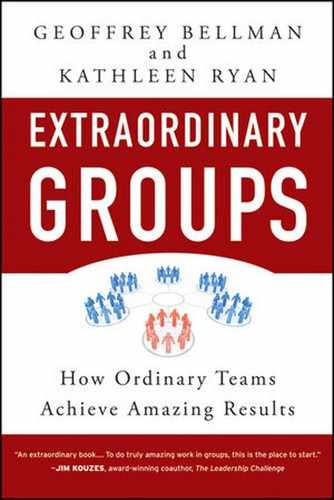We two have been personal friends and professional colleagues for over twenty-five years. We share a strong Bond built upon our friendship and a mutual compelling Purpose—this book. During our three years of work on Extraordinary Groups, we sought to be extraordinary. We intended to transform ourselves, our relationship, our ideas, and our work through this co-authoring. And, we did—often in ways that surprised both of us.
As one small group of two, we worked to meet the six Group Needs we each brought to this project. We observed our behavior and discussed how it was or was not characteristic of extraordinary groups. And we noted our feelings, how and when we each felt energized, connected, hopeful, and changed by the work we have done together. And we have been successful in ways unimagined at the beginning; we wrote quite a different book and in quite a different way than we anticipated. This whole experience has been transforming for each of us; our partnership has been extraordinary in ways we didn't expect and have seldom experienced.
We recently asked ourselves, "What guides your interactions with your co-author on this book?" We each listed our guides, shared the lists with each other, and offer them to you here. As you read them, notice links to Acceptance and Potential, Bond and Purpose, Reality and Impact. Notice the differences in the two lists. And consider how our lists might fit with your own if you were to list what guides you in your interactions with others in one of your groups.
Kathleen has successfully collaborated on two books, is inclinedto reach out to others before writing, and outlines what she intends to write before writing.
The relationship is most important; we are committed to each other and helping each other be happy and healthy in the whole of our lives.
We care equally about our Purpose and both have absolutely positive intentions.
Play to Geoff's strengths and interests and minimize the times when I ask him to do things in a way that doesn't fit naturally.
Act with a spirit of discovery and exploration—take a few steps, then see what we learn; take the next obvious step and see where that leads; stay open to the creative possibilities that come because he sees things differently than I do.
Get things to a point of being good enough to move ahead; avoid perfectionism.
When needed, disagree directly and with an open spirit. Share feelings; say what's going on if it's a bad day. Do not be intimidated by his strengths or strength of feelings.
When confused or frustrated, ask: How important is this to you? To us? To the book? Give him space; don't over-talk an issue. Short conversations are better for him.
When dealing with our differences: Listen for and respond to the feeling underneath the words. How can I help this be good for Geoff? What is it that he wants or needs? What is it that I need?
Express appreciation and affection, excitement about the writing and our process. Celebrate, even briefly, milestones.
Maintain a sense of humor.
In crunch time, deliver; keep commitments.
Geoff has written five books by himself, is inclined to hole up alone and write, and prefers writing without structure to see what will happen.
My ego is behind most of my discomfort. What is Ego saying to me?
Her motives serve our relationship and our book. Notice when you question this.
Reinforce what she brings to the process. Large and small contributions.
Our complementary styles feed creativity and disagreement.
Her style has worked for her just as well as my style has worked for me.
This book is less important than our relationship.
A reminder: I have learned so much through our engagement in this process.
Watch for patterns in my difficulties. Act on those—first alone and then with her.
Notice my need for control. Notice what happens when I let go.
Our meetings have been essential in shaping this book.
We two authors, confirmed in our separate experiences and styles, needed something more important than either of us to allow our creative collaboration. What we found is represented in our lists, and the lists are informed by our model. Our work together offered more exhilaration than anguish, but included both. We lived the challenges of embracing differences again and again. And we came through our differences with a deepened appreciation of our book and each other. None of that would have been there without our differences: pulling apart regularly to find our edges preceded pulling together, always first within the Bond of friendship and shared Purpose. Then, supporting each other with Acceptance and Potential, and together reaching toward Reality and Impact.
